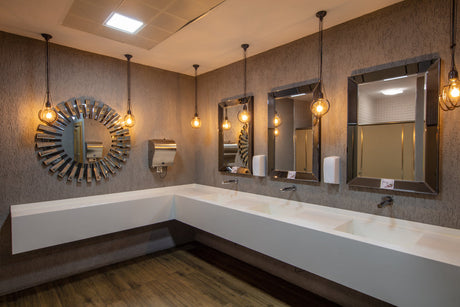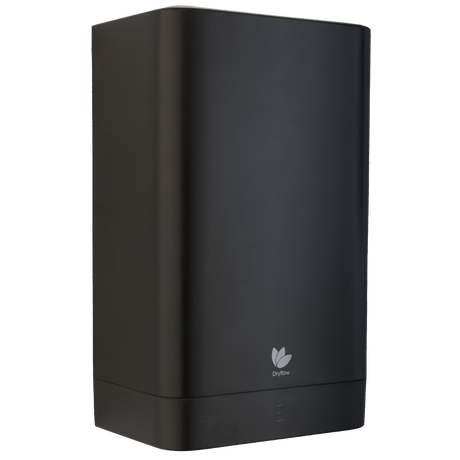Agents, designers, builders, installers and eventually owners are responsible for complying the different building rules. In order to explain to professionals the regulations in the sector, the government published several texts. The file most relevant to reduced mobility is Approved Document M (AD M), which deals with the access to and use of buildings in England. Other documents (C and mostly K) complete its guidance on steps, stairs or ramps and the most suitable handrails for them. It is vital that any accessible bathroom is designed with a suitable configuration of grab rails to ensure maximum mobility and safety.
How do you know which grab rails are the right choice for you? Well, we’ve answered that very question in this blog post. Have a look!

Both volumes of Document M recommend the four following concepts regarding grab rails in adaptable or accessible toilets for elderly or disabled people.
1) Clear space in the walls
Householders might need to fix some grab rails or drop-downs, so when designing the dwelling one must ensure that fitting these supports would be an easy task in the future. In detail, when these sanitary conveniences are meant to be accessible to wheelchair users, there must be a zone of 1000mm long, 1000mm high and 100mm wide kept unoccupied next to the WC to enable the installation of grab handles. In the diagram 3.11 extracted from Doc M (volume I) it is represented as a hatched area.
WC room in wheelchair-accessible dwellings

2) Strong walls to support grab rails
In adaptable and wheelchair-accessible dwellings, any wall in a washroom, bathroom or shower room has to be “strong enough to support grab rails, seats and other adaptations that could impose a load of 1.5kN/m 2 .”
3) Enough contrast between colours
Every component (walls, tiles, grab rails ) can have a light reflectance value (LRV) on a scale from 0 to 100. More and more, manufacturers indicate this number on the specifications of products. The luminance contrast between two items consists of the difference between their LRVs .
At least in buildings other than dwellings, the surface of the grab rails must “contrast visually with the background wall and floor finishes,” what means that the difference between the LRVs must be more than 30 points in average light circumstances. Such a high contrast is essential for people with visual impariments or conditions like dementia .
For example , if we have a pale beige painted wall that scores around 77, a white grab rail with 87 value would not be suitable, since the difference is only 10 points; instead, we could choose a brushed stainless steel grab handle whose value is 45, resulting a contrast greater than 30 points.
4) Recommended locations and minimum distances
Different length, type and quantity of support rails will be required in relation to the cubicle and its purpose (WC, shower, bath, changing). The fact that some of these bars can be swung-up is essential to make the most of the space in the room; for example, it could be needed to use a hoist.
Doc M also indicates that a horizontal closing rail should be put at the inside face of the door ; it must also contrast visually with the surroundings.
-
These are the different requirements for
WC
rooms
of commercial buildings; keep in mind that the distances may vary depending on the model of toilet (close coupled, back-to-wall or wall-hung):
- A unisex wheelchair-accessible toilet or compartment will have four grab rails: two horizontal bars on either side of the WC, two vertical grab rails on either superior side of the basin. When it is a corner WC, one horizontal grab rail is mandatory on the wall next to the WC, whether wall mounted or drop-down. An additional drop-down rail is needed between both when the adjacent grab bar is more than 400mm from the toilet; this would be the case of peninsular WCs. On the open side of this WC, a drop-down rail is normally fixed (320mm from the centre of the toilet). Check diagrams 18, 19 and 20 of Document M (volume II). Grab rails in a unisex wheelchair-accessible toilet with corner WC: Plan. As we can conclude from the first diagram, the drop-down grab rail should be at least 750mm long and the wall clearance of the horizontal 600mm straight grab rail next to the toilet is expected to be from 60mm to 85mm. Grab rails in a unisex wheelchair-accessible toilet with corner WC: Wall A view. This diagram above displays a supporting height of the straight and drop-down grab rails of 680mm from the floor. Grab rails in a unisex wheelchair-accessible toilet with corner WC: Extra heights
- Any wheelchair-accessible washroom for men will have two 600mm long vertical grab bars, either side of the urinal, with their centre lines at 1100mm above the floor.
-
The compartments for
ambulant
disabled people (those restricted but not using a wheelchair) require two or three grab rails, at least 500mm long. You can follow the instructions in the diagram 21 below.
Grab rails in a cubicle for ambulant disabled people
- An enlarged compartment for people who need extra space (person with baby, mobility restrictions or luggage) requires a horizontal grab bar adjacent to the WC and a vertical grab bar on the rear wall.
- In changing, shower and bathroom facilities in buildings other than dwellings, layouts must be suitable for left-hand and right-hand transfers unless there is another similar room with WC. Wall-mounted drop-down support rails and wall-mounted slip-resistant tip-up seats (that can reach the emergency cord) must be provided inside the curtain area. In a bathroom, the transfer seat should be 400mm deep and equal to the width of the bath. You can check diagrams number 22 for the changing facilities, 23 for the shower and 26 for the grab rails in the bathtub on the Doc M (volume II). Please notice that the clearance between the wall and the long horizontal grab bar next to the bathtub is expected to be from 50mm to 60mm. It will be difficult to provide a configuration that is suitable for all disabilities. Grab rails in accessible changing facilities Grab rails in an accessible shower Grab rails in an accessible bathtub
- To see an example on how to incorporate a corner WC in a shower room or bathroom, please check diagrams 24 and 25 in Document M. We should contemplate the diversity of users when preparing sanitary facilities. Apart from restrictions in their movements, people may have learning difficulties, a cardiac disease, lack of tactile sensitivity or visual or hearing impairments. Let’s put no obstacle in the way to personal hygiene and offer support points to boost independence and help their companions. Rights and accuracy disclaimer: This blog post contains information and diagrams included in Document M according to its Open Government License v3.0 . Nonetheless, there could be mistakes in our interpretation and summary, so please consult the source text and professionals. To read about recommendation in Ireland, please check what point 5 of Building for Everyone dictates.
- If you want to read more about the building regulations and grab bars placement, we encourage you to take a closer look at Document M (last amended in 2016) and the Planning Portal. In case you still have any doubt, you could consult an approved inspector, a technical body or a local building authority. As for what grab rail you could choose , we have at your disposal several lengths, finishes and surface mountings in this section as well as Doc M packs . To find out the best grab rail according to your needs, we advise you to contact us directly, check this factsheet or reach an occupational therapist.





